Manual WVU27D1 WVU27X1
2016-04-20
: Whirlpool Manual-Wvu27D1-Wvu27X1 Manual-WVU27D1-WVU27X1 05 2015 uploads wp-content
Open the PDF directly: View PDF ![]() .
.
Page Count: 23
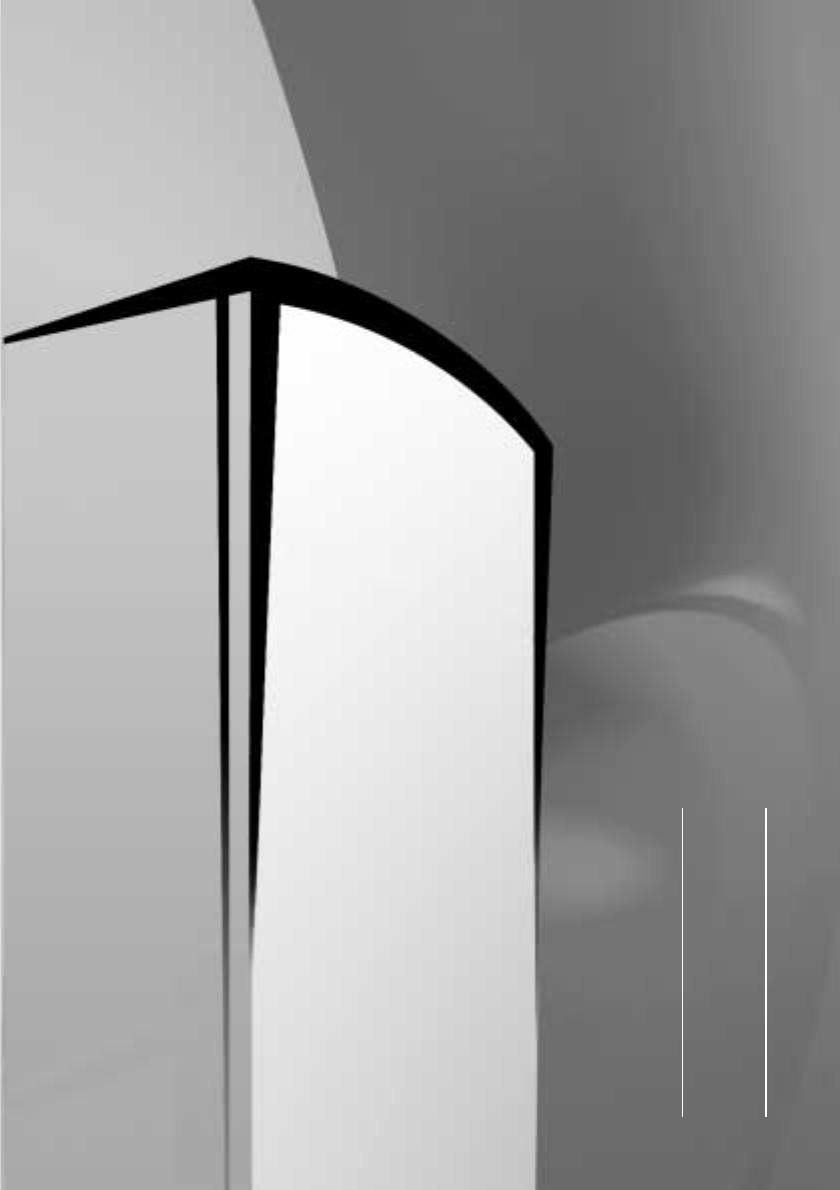
FREEZER
260/300

ENGLISH Page 1
ESPAÑOL Página 11
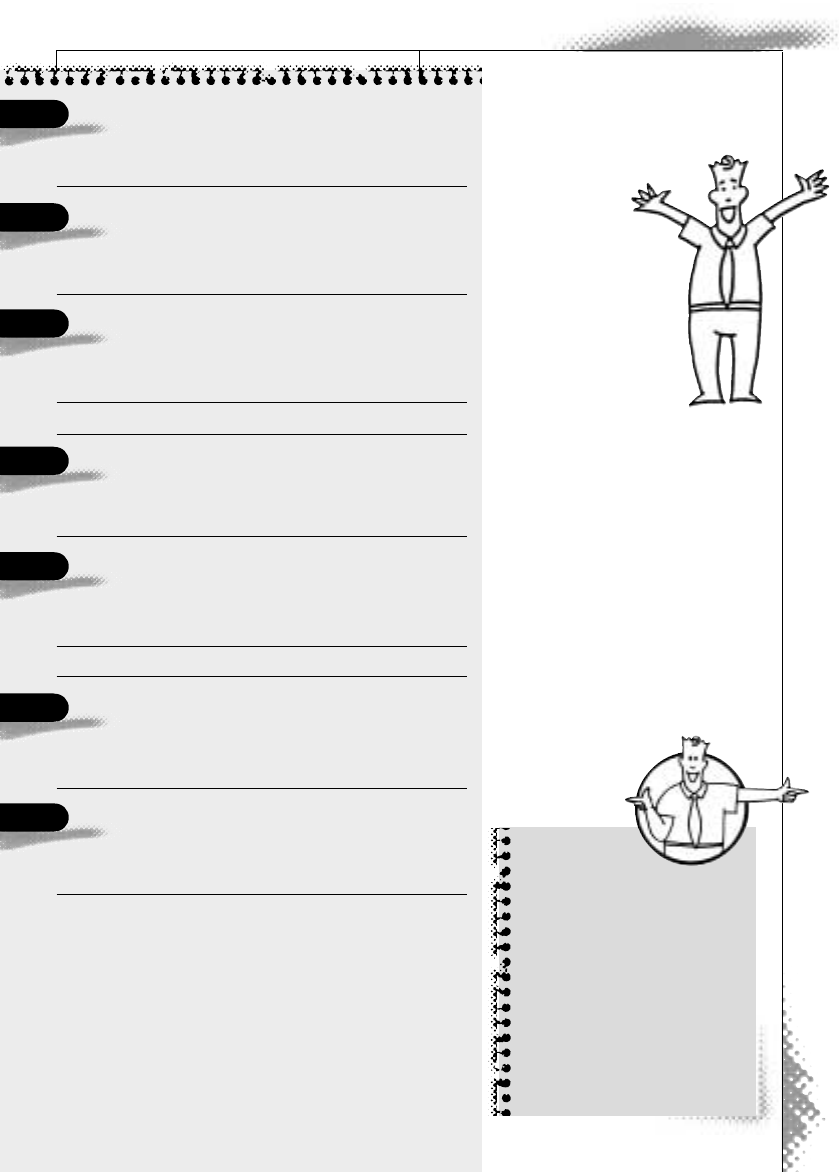
1
ENGLISH
Contents
2
3
4
5
6
7
1SAFETY WARNINGS 2
WHERE DO I START?
✔Installing 3
USING THE FREEZER
✔How to Operate the Freezing Control 5
✔Storing Food 6
FREEZER COMPONENTS
✔Fast Freezing 7
MAINTENANCE AND CARE
✔Defrosting and Cleaning 7
✔When You are Away 8
TROUBLESHOOTING MINOR PROBLEMS
✔9
TECHNICAL CHARACTERISTICS
✔10
Congratulations
You have just acquired a
product which features
both safety and quality.
This product line
represents
a true
innovation in
terms of design
and concept.
We prepared this
manual for your
wellbeing and of
your family.
It contains simple,
objective instructions for
you to take maximum
advantage of your freezer,
offering comfort, safety,
and power economy, just
as you deserve.
Start here
If you want to take
maximum advantage of
the technology
incorporated by this
freezer, read the entire
manual.
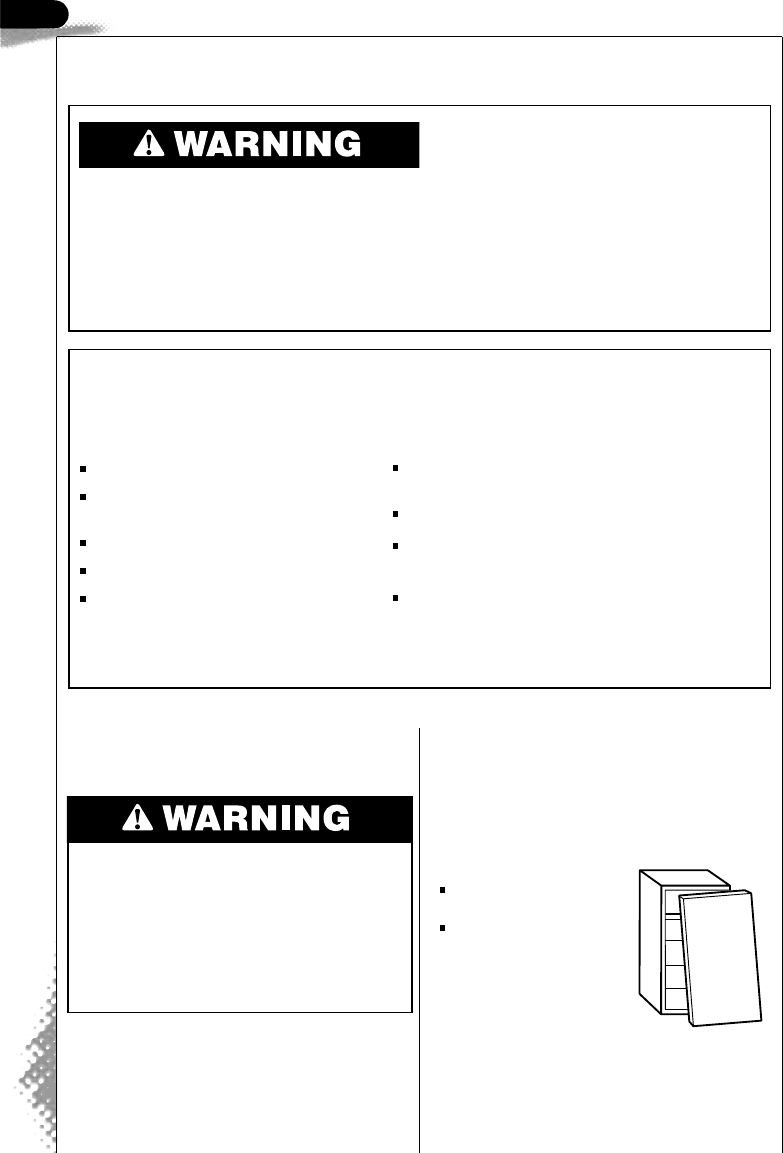
This is the safety alert symbol.
This symbol alerts you to potential hazards that can kill you or hurt you if you
don’t follow safety instructions.
All safety messages will tell you what the potential hazard is, tell you how to reduce
the chance of injury, and tell you what can happen if the instructions are not followed.
FREEZER SAFETY
IMPORTANT SAFETY INSTRUCTIONS
WARNING: To reduce the risk of fire, electric shock, or injury when using your
freezer, follow these basic precautions:
Do not remove the ground wire.
Connect the ground wire to an
effective ground.
Do not use an adapter.
Do not use an extension cord.
Disconnect power before servicing
or cleaning the product.
KEEP THESE INSTRUCTIONS IN MIND
After cleaning or servicing, replace all
components before turning the product on.
Use non-flammable cleaning products.
Keep flammable materials such as gasoline
away from the freezer.
Use two or more people to move and install
the freezer.
Proper Disposal of
Your Old Freezer
Suffocation Hazard
Remove doors from your old
freezer.
Failure to do so can result in
death or severe injuries.
Junked or abandoned freezers are still
dangerous especially for children as they
may get stuck inside the product, running
the risk of suffocation.
Before you throw away your old
freezer:
Take off the doors.
Leave the shelves in
place so that children
may not easily climb
inside.
1Safety Warnings
2
ENGLISH
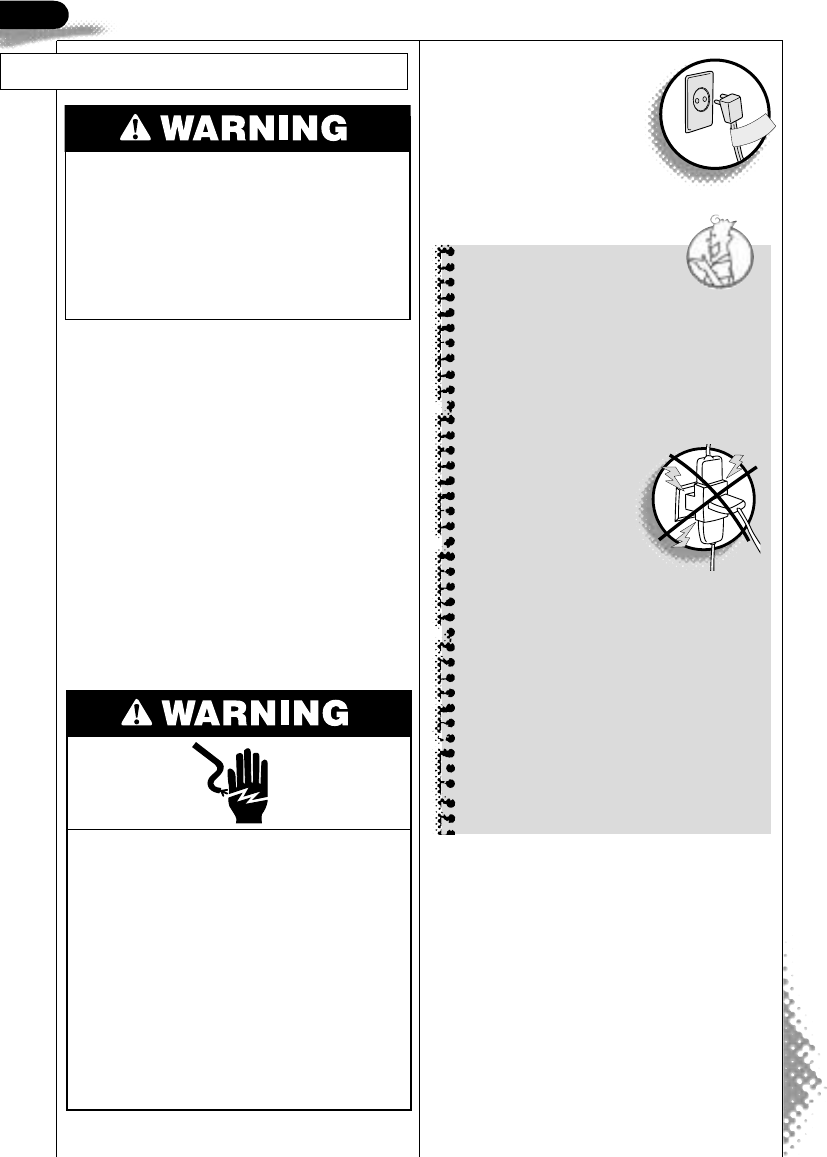
2
3
ENGLISH
Where do I start?
Before turning on:
✔ Remove base from packaging.
Remove wedges and tapes from the
internal components.
✔Clean your product inside with a
soft cloth or sponge, lukewarm
water and mild soap.
✔ Do not use sharp objects, alcohol,
flammable products or abrasive
cleaners. They can damage the
painting of your freezer and/or
refrigerant circuit.
✔Do not place nor use electrical
apparatuses within the product.
Important:
✔Never connect your freezer to
double or triple extension
cords together with another
appliance in the same wall
outlet. Do not use an extension
cord. That may overload power
supply, impairing the
operation of your
freezer, and
resulting in
fire accidents.
Use an exclusive
wall outlet only.
✔In case of voltage oscillation,
install an automatic voltage
stabilizer with power output of
at least 1000W between the
freezer and the wall outlet.
✔If the power supply cord is
damaged, it must be replaced
by one of the same type or by
a special set provided by the
manufacturer or its authorized
technical service.
INSTALLING
Excessive Weight Hazard
Use two or more people to move
and install the freezer.
Failure to do so can result in back
or other injury.
Electrical Shock Hazard
Connect the ground wire to an
effective ground.
Do not remove ground wire.
Do not use an adapter.
Do not use an extension cord.
Failure to follow these
instructions can result in death,
fire or electrical shock.
✔Check if the voltage
supplied is the same
as that on the tag
attached near the
plug. The freezer
shall be connected to
a good wall outlet.
V
O
L
T
A
G
E
Power supply of your residence:
The electric wires of your residence
shall be of copper and have minimum
sections of 2.5mm2.
Ground wire (grounding):
For your safety, properly connect the
freezer ground wire (green wire
behind the product). Improper
connection of the ground
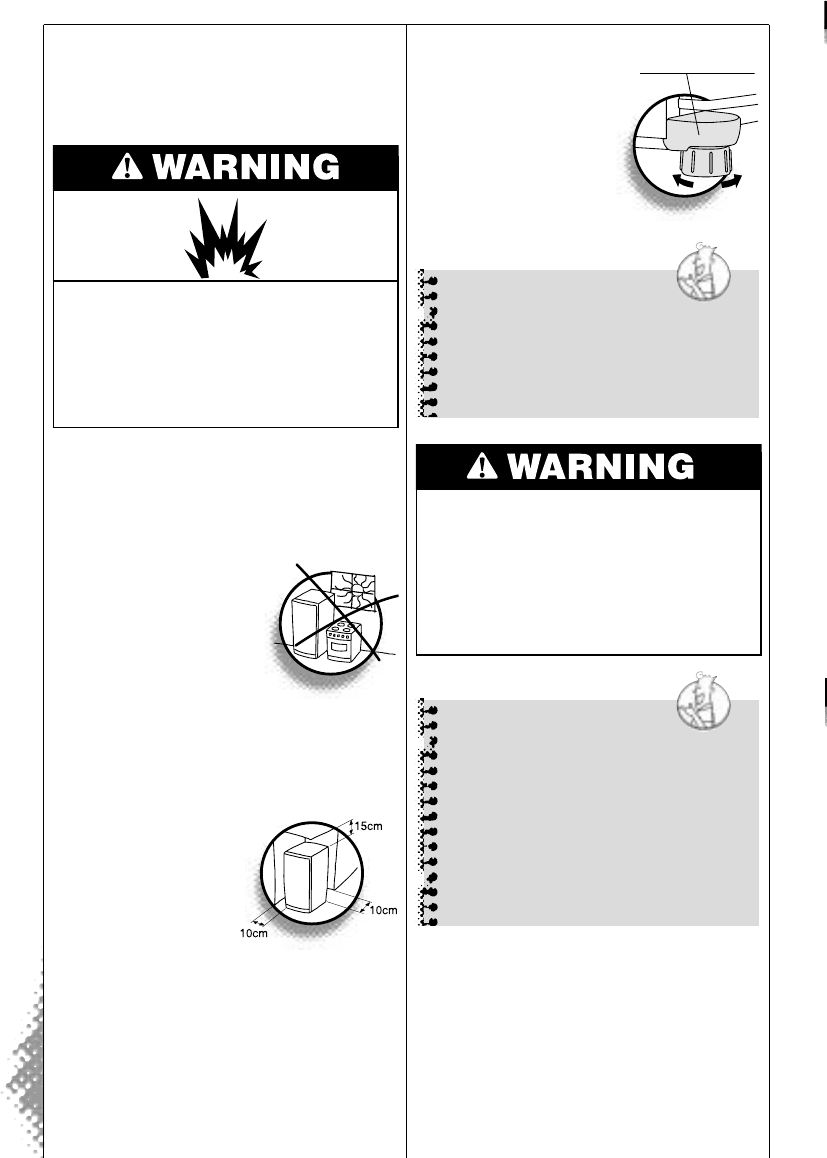
4
ENGLISH
Location:
The freezer shall neither be installed
near heat sources (stove, heater etc.)
nor in a location where it is exposed to
direct sunlight.
Installation in an
inadequate location
impairs the operation
of the freezer and
increases power
consumption.
How to build in:
Consider the following minimum
distances to assure good air
circulation:
✔10 cm
at the sides.
✔10 cm
at the back.
✔15 cm at the top.
By doing so you will ensure the good
performance of the product.
You will also prevent your freezer
components from touching walls, other
products or furniture avoiding
unpleasant noise.
Explosion Hazard
Keep flammable materials such
as gasoline away from freezer.
Failure to do so can result in
death, explosion, or fire.
Important:
✔ To facilitate the closing of
door, turn the stabilizing feet a
little further, slightly tilting the
product backwards.
Door reversal:
Your freezer leaves factory opening to
the left. In case you wish the doors to
open to the right, call a service agent
or your dealer to avoid the risk of
accidents. Door reversal is not
covered by the warranty. This service
will be charged.
Fire Hazard
Never place lit candles or similar
products (oil lamp) on top of the
freezer.
Failure to follow this instruction
can result in life or fire risk.
Leveling feet:
Place the freezer in its
final position. Turn the
stabilizing feet
located in the front of
the product so that
they touch the floor,
leveling the product.
Heating on the sides:
✔Heating of some external areas
of the freezer is normal. That
happens to avoid the formation
of moisture. However, under
critical conditions of room
temperature and humidity,
moisture may be observed. Dry
the product with a soft cloth.
wire may result in electrical shock or
other injuries. If the installation site is
not provided with grounding, check
with a reliable electrician to provide it.
Stabilizing feet
protection
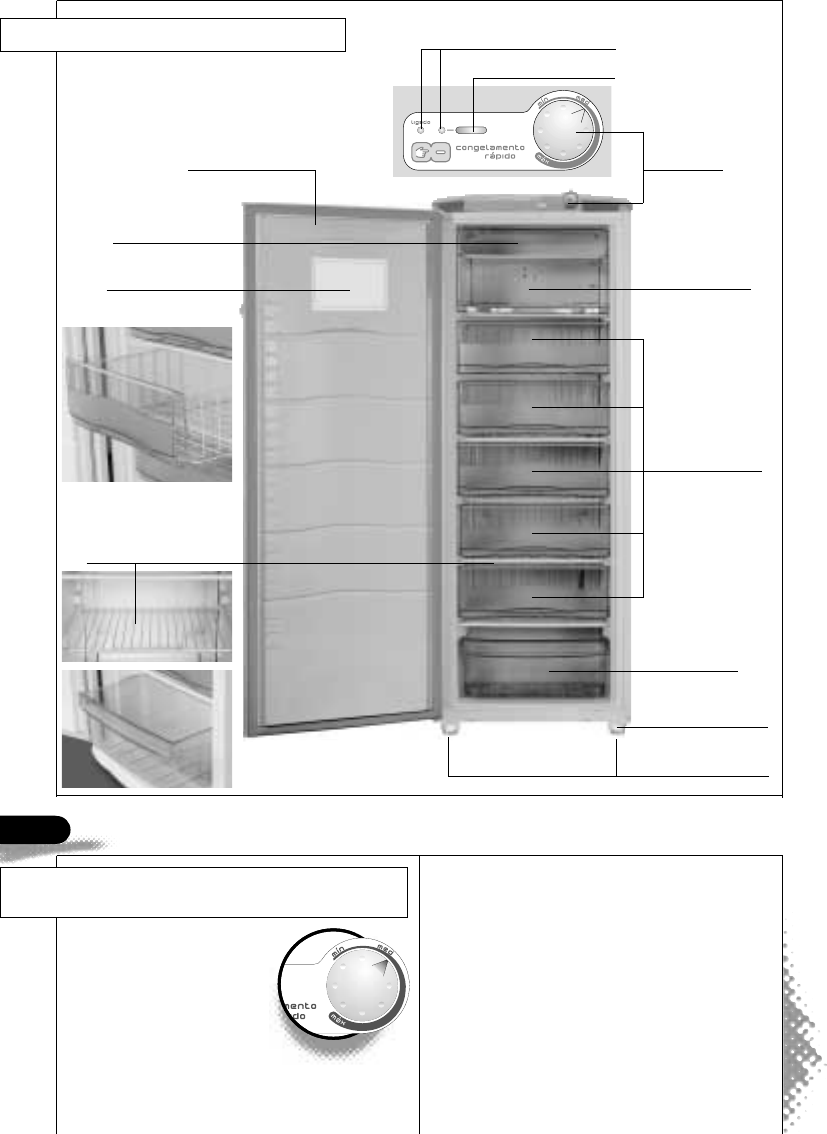
5
ENGLISH
GENERAL CHARACTERISTICS
Tag with Usage
Information
Stabilizing Feet
Freezing
Control
Fast Freezing
Compartment
Upper
Compartment
Lower
Drawer
(removable)
Stabilizing
Feet Protection
Removable
Baskets
(for model 260
4 baskets)
Reversible Door
Removable Wire
Shelf
(for model 260)
Leds
(power and fast freezing)
Fast Freezing Key
3Using the Freezer
The internal
temperature of you
freezer can be set to
better meet food
preservation
conditions according
to the room
temperature of your house.
HOW TO OPERATE THE
FREEZING CONTROL The freezing control of your freezer
leaves factory set to medium.
To adjust the control, do follow the
table below.
To adjust the internal temperature,
rotate the freezing control knob to the
desired settings.
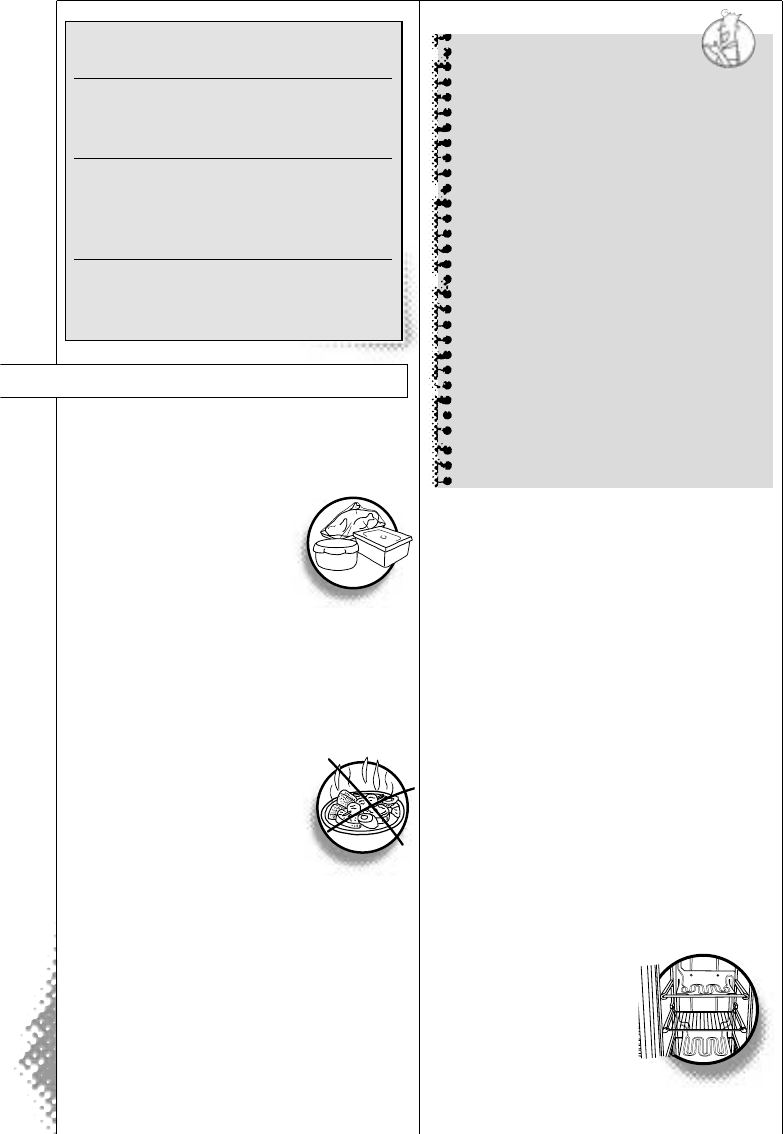
6
ENGLISH
✔Food shall be stored in adequate
packages like plastic bags or
containers with hermetic lids.
This procedure avoids
the removal of natural
humidity from the
food, preserving
quality.
✔When storing food in
the freezer, prepare small portions to
allow faster freezing and the entire
use of each portion.
✔Do not place hot foods inside the
freezer. Allow them to cool to room
temperature. That helps
saving power
consumption, and
assures the good
operation of the
product.
✔Try to open the door
only as long as it takes to place and
remove food. You will be reducing
power consumption and improving
the performance of your freezer.
✔Allow at least 1 minute before
opening the freezer door.
The internal vacuum makes opening
of the door difficult immediately
after it has been closed.
Position -
freezing level
Minimum
Medium
Maximum
Room
temperature
✔
Cold days with
temperature
below 20°C
✔
Days with
temperature
between
20°C and 35°C
✔
Hot days with
temperature
above 35°C
STORING FOOD
Important:
✔It is recommended to operate
the freezer for at least 2 hours
before storing food or beverages
in it. That time is necessary for
temperature to stabilize inside
the product.
✔Once defrosted, foods should
not be refrozen as they might
lose their natural characteristics.
✔Liquids increase in volume
when frozen. Take care when
storing bottles or other closed
containers in the freezer.
They may brake.
✔Do not store toxic products in
your freezer as they may
contaminate foods.
✔Each freezer is able to freeze a
maximum amount of food at every
24 hours. Avoid exceeding the
freezing capacity of your product.
See “Technical Characteristics”
(pg. 10).
✔Always observe the expiration date
of frozen food, indicated by the
manufacturer.
✔When opening the door, it is
normal for the lower drawer, basket
fronts and the door of the fast
freezing compartment of your
freezer to fog up due to the entry of
hot air.
Using the shelf (removable):
To store a bigger amounts of food or
large foods, remove the
baskets and shelves.
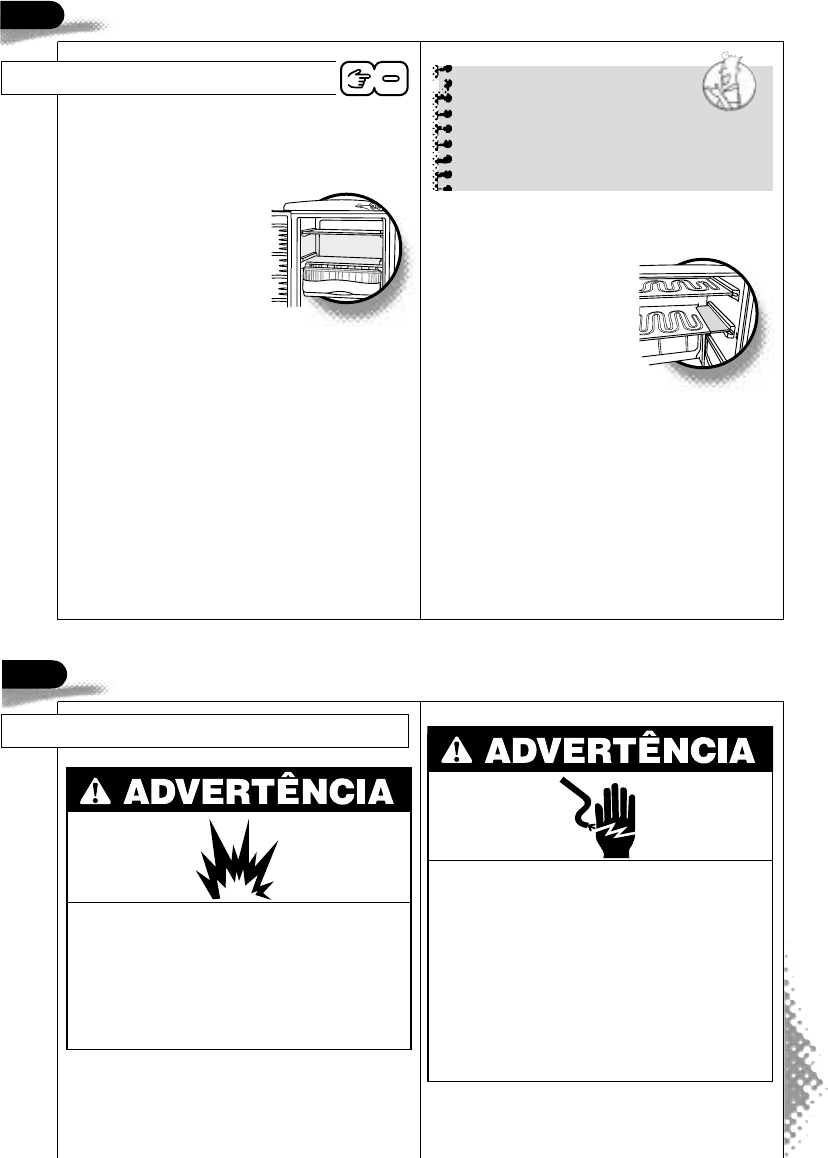
7
ENGLISH
Freezer Components
4
Fast freezing is an effective way to
preserve the natural characteristics of
food. When fast freezing, the ice
crystallization phase - that takes place
between 0°C and -5°C
- is faster which
minimizes the loss of
water in the food and
preserves its natural
constitution.
Food freezes gradually.
✔Your freezer is provided with a
compartment ideal to speed up the
freezing of foods.
✔For a faster freezing, place food in
this compartment and press the fast
freezing key in the control panel.
The yellow light in the panel will go
on, indicating that the fast freezing
function is actuated.
This function does not turn off
automatically.
FAST FREEZING Important:
✔We recommend to turn the
fast freezing function off after
26 hours.
M
Í
N
I
M
A
M
✔These models of freezers are
provided with a
plastic complement
on the right-hand-
side of the second
shelf. Under normal
usage conditions,
there will be no ice
formation in this
area.
✔In case you wish to interrupt the
fast freezing function, at any time
press the key that actuates this
function.
✔See freezing capacity in “Technical
Characteristics” (pg. 10).
Maintenance and Care
5
DEFROSTING AND CLEANING
Explosion Hazard
Use nonflammable cleaner.
Failure to do so can result in
death, explosion, or fire.
Electrical Shock Hazard
Disconnect power before
servicing.
Replace all components before
turning on the product.
Failure to do so can result in
death or electrical shock.
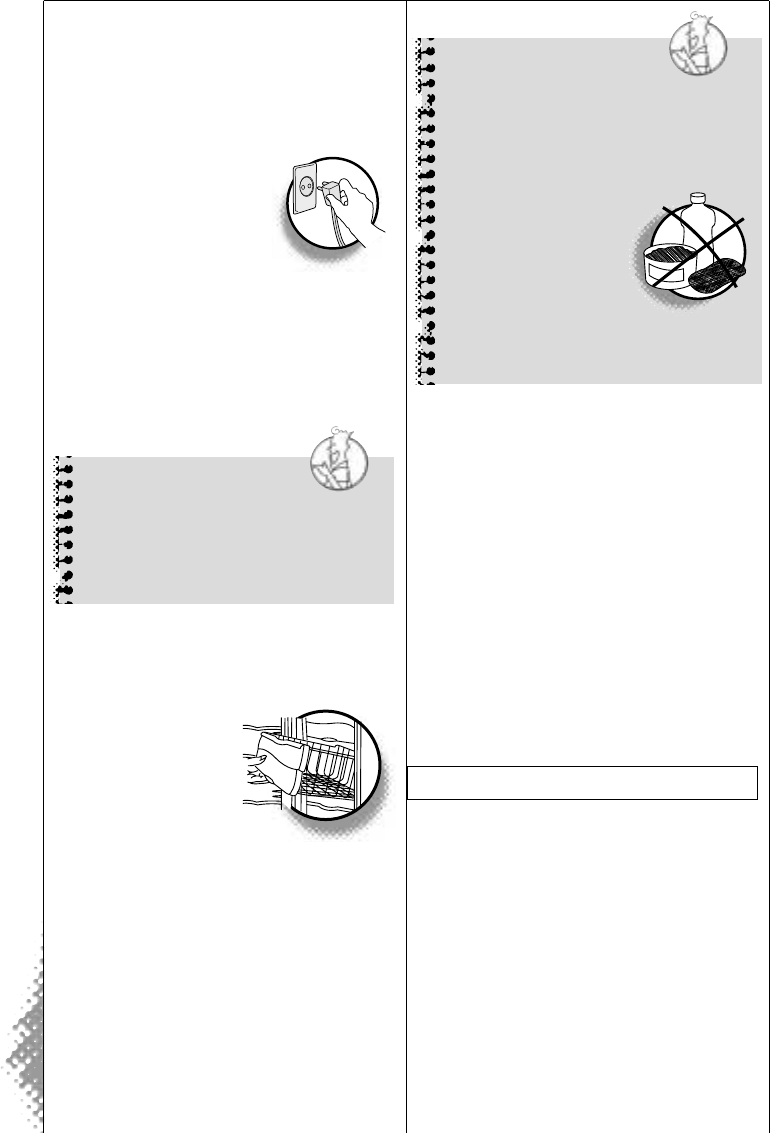
8
ENGLISH
It is recommended to defrost the
product at least every six months or
whenever the ice layer is 1 cm thick.
Defrosting shall preferably be done
when there is not much food in the
freezer. Follow the steps
below.
✔Before defrosting
and/or cleaning the
product, unplug it.
✔Pack foods and place one packet
next to the other in the coldest
place of your refrigerator or in a
thermal container.
✔Leave the door open to speed up
defrosting.
Important:
✔Do not use sharp
or cutting objects to remove the
ice. They may damage the
product.
✔Properly place the lower drawer.
Most of the defrosting water will
flow to that drawer.
✔To remove
baskets, pull and
lift them.
✔When defrosting
is finished, remove the drawer and
get rid of the water.
✔Clean the inside part of your
freezer.
Important:
✔ Never use toxic (ammonia,
alcohol, removers, etc.), abrasive
products (scouring cleansers,
powders etc.), scouring pads or
brushes when cleaning
your freezer.
They may damage
your freezer
and leave an
unpleasant smell.
✔Do not let those products get in
touch with your freezer as they
may damage it.
✔Use a soft cloth or sponge soaked
in water with mild detergent/soap.
Rinse well and dry with a clean,
dry cloth.
✔To clean the outside back part of
the product, use a vacuum cleaner
of duster only.
✔After cleaning, connect the plug to
the wall outlet.
If necessary, set the freezing
control to the position desired.
WHEN YOU ARE AWAY
✔Remember, that there may be a
power supply failure for a long
period of time and that defrosting of
food may cause its degradation.
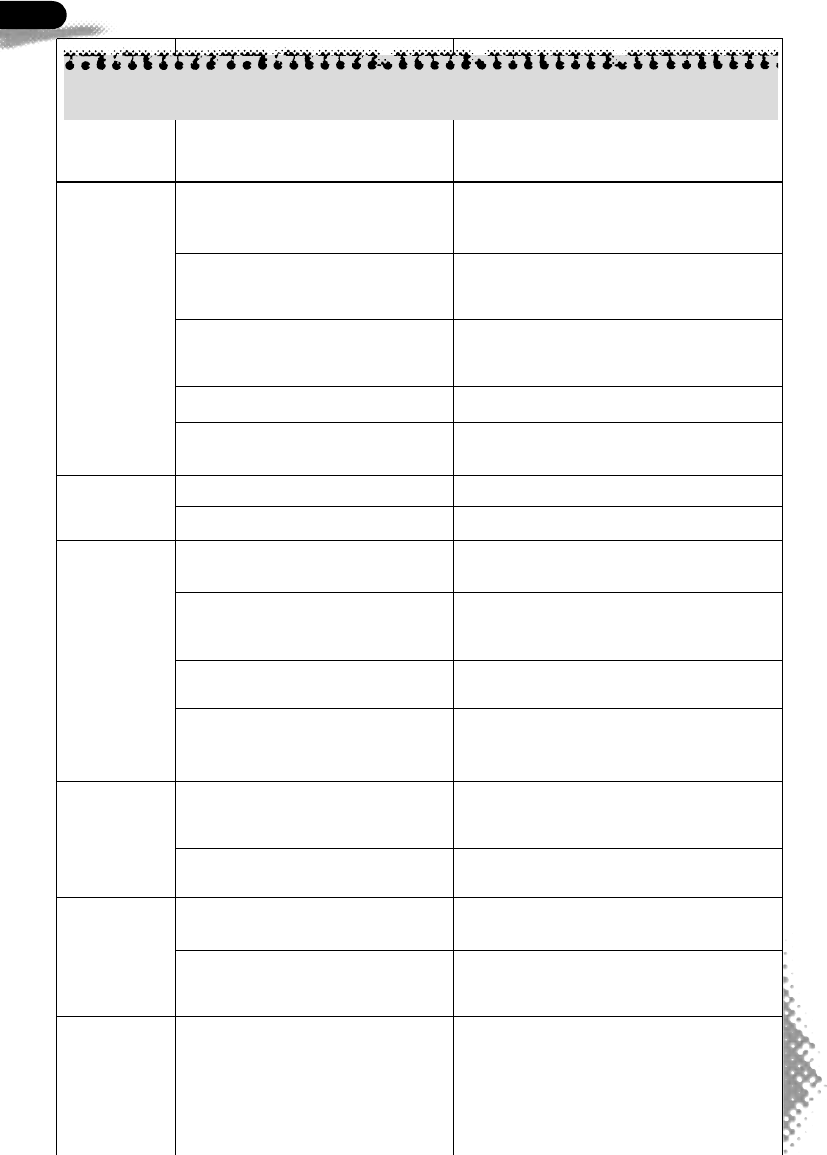
9
ENGLISH
Check whether the power led is on.
Also check whether product is
plugged in.
Install an automatic voltage
stabilizer (min 1000 Watts) 3
Check the wall outlet by plugging
in another appliance.
Replace if necessary.
Plug it in.
Call the assistance shop or your
dealer. 3
Refer to “Where do I Start?” (Installing). 4
Level stabilizing feet. 4
Adjust it as per “Using the Freezer
(How to Operate the Freezing Control). 5
Check whether something is impairing
the closing of the door.
If necessary, rearrange food.
Tell people to open the door
only when necessary. 6
Observe maximum freezing capacity;
use fast freezing compartment. 7
Press fast freezing key.
Install your freezer in a ventilated
place. 4
Dry the product with a soft cloth.
Level stabilizing feet so as to keep the
freezer slightly tilted backwards. 4
Tell people to open the door
only when necessary. 6
Pack food and/or close
containers with liquids. 6
Check whether something is impairing
the closing of the door. If necessary,
rearrange food in the freezer.
Call the authorized service
shop or consult your dealer.
PROBLEM PROBABLE CAUSE SOLUTION
Freezer fails
to go on
Weird noises
Insufficient
refrigeration
Outside sweat
Inside sweat
Ice formation
No electricity supplied.
Voltage excessively low/high
(observe oscillation of lamps in the
house).
Defective wall outlet.
Product unplugged.
Power supply cord damaged.
Installation in an inadequate place.
Inadequate leveling.
Freezing control in wrong
position.
Door not properly closed.
Excessive opening of the door.
Excessive load to be frozen. Food to
be frozen placed outside the fast
freezing compartment.
High air humidity (normal in
certain climates and seasons).
Poor sealing of magnetic gasket that
surrounds the door.
Excessive opening of the door.
Unpacked food and/or open
containers with liquids (excessive
humidity).
Infiltration of humidity through
the door.
MORE
INFORMATION
ON PAGE
Before calling your service shop or dealer, try the solutions in the following table.
6Troubleshooting Minor Problems
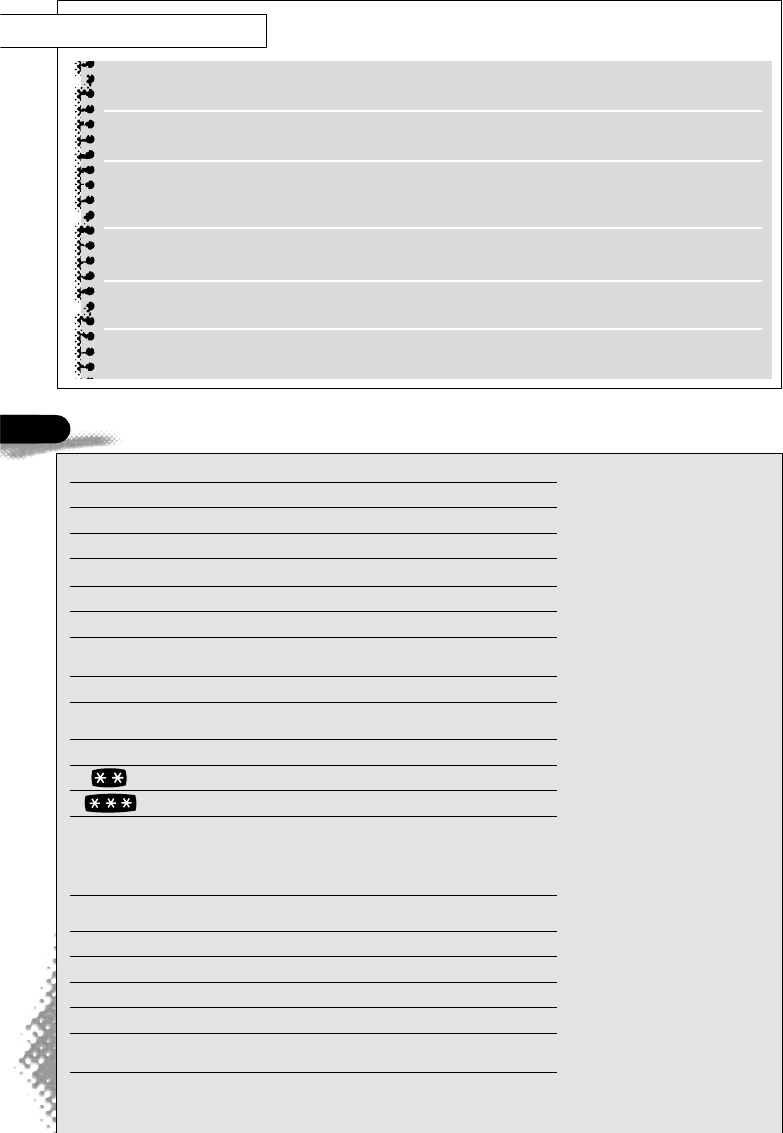
10
ENGLISH
Cracks are due to displacement of ice. It is the same noise of ice trays
being exposed to room temperature.
This noise is characteristic of the motor.
It means that the compressor is operating.
This noise is characteristic of gas expansion in the refrigeration system.
It is a noise similar to the one generated when we inflate a gas
balloon.
This noise is characteristic of water flowing.
It happens when the product is defrosting.
It happens when closing the door. The noise is similar to air being
released from a gas balloon.
Noise characteristic of vibrating parts. It happens when the baskets are
empty
Cracks
Compressor
noise
Gas
expansion
noise
Defrosting
noise
Gasket
noise
Internal
noise
NORMAL NOISES Some noises are considered normal to the operation of
the freezer. Find below a table with such noises.
Model 300 260
Dimensions without package (mm) (mm)
Height 1700 1539
Width 616 616
Width with door open at 130° 1139 1139
Depth 691 691
Depth with door open at 90° 1206 1206
Gross capacity (liters) (liters)
Total 296 260
Capacity(*) (liters) (liters))
Total 246 231
Upper compartment 20 20
Freezer compartment 226 211
Freezing capacity
(in up to 24 hours with the
fast freezing key pressed) 11,0 kg 10,0 kg
Maximum weight on components (kg) (kg)
Fast freezing compartment 20,0 20,0
Baskets (each) 20,0 20,0
Lower drawer 20,0 20,0
Shelf 20,0 20,0
Weight without package (kg) 63,0 56,0
7Technical Characteristics
The manufacturer
reserves the right to
alter the general,
technical and
aesthetic
characteristics of their
products without
prior notice.
*To obtain maximum
storage capacity from
model 260, remove
all baskets with the
exception of the first
basket below the fast
freezing compartment.
In model 300, remove
the second and fourth
baskets.
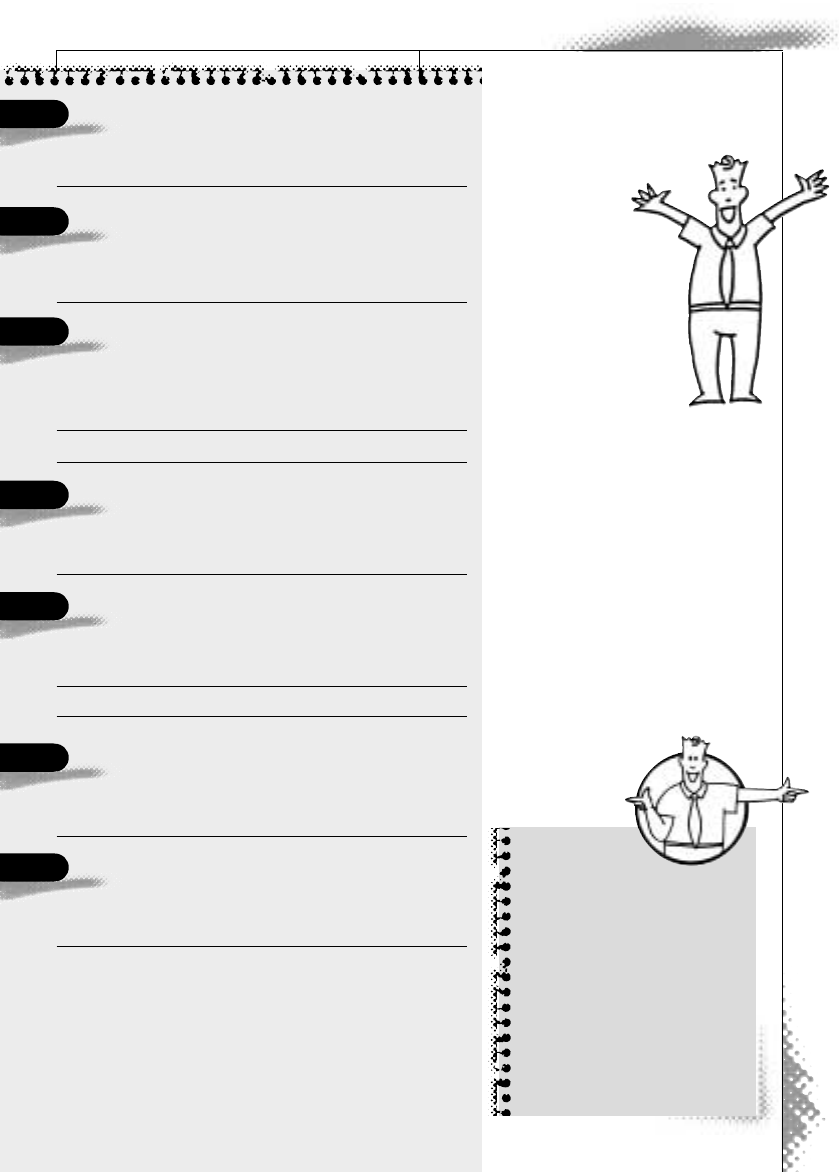
11
ESPAÑOL
Contenido
2
3
4
5
6
7
1AVISO DE SEGURIDAD 12
POR DÓNDE EMPIEZO?
✔Instalando 13
USANDO EL FREEZER
✔Cómo Operar el Control de
Congelamiento 15
✔Almacenando Alimentos 16
COMPONENTES DEL FREEZER
✔ Congelamiento Rápido 17
MANTENIMIENTO Y CUIDADOS
✔ Descongelamiento y limpieza 17
✔Viajes y Ausencias 18
SOLUCIONES DE PEQUEÑOS PROBLEMAS
✔19
CARACTERÍSTICAS TÉCNICAS
✔20
Felicitaciones
Ud. acaba de adquirir un
producto que ofrece tanto
seguridad como calidad.
Esta línea de
productos
representa
una verdadera
innovación en
términos de
diseño y concepto.
Hemos preparado
este manual para
su bienestar y el
de su familia.
Este contiene instrucciones
simples y objetivas para
que Ud. obtenga el
máximo provecho de su
freezer, el cual le ofrece
confort, seguridad, y
ahorro de energía, como
Ud. se merece.
Empiece por aquí
Si Usted desea
obtener el máximo
rendimiento de la
tecnología incorporada
en este freezer, lea
todo el manual.
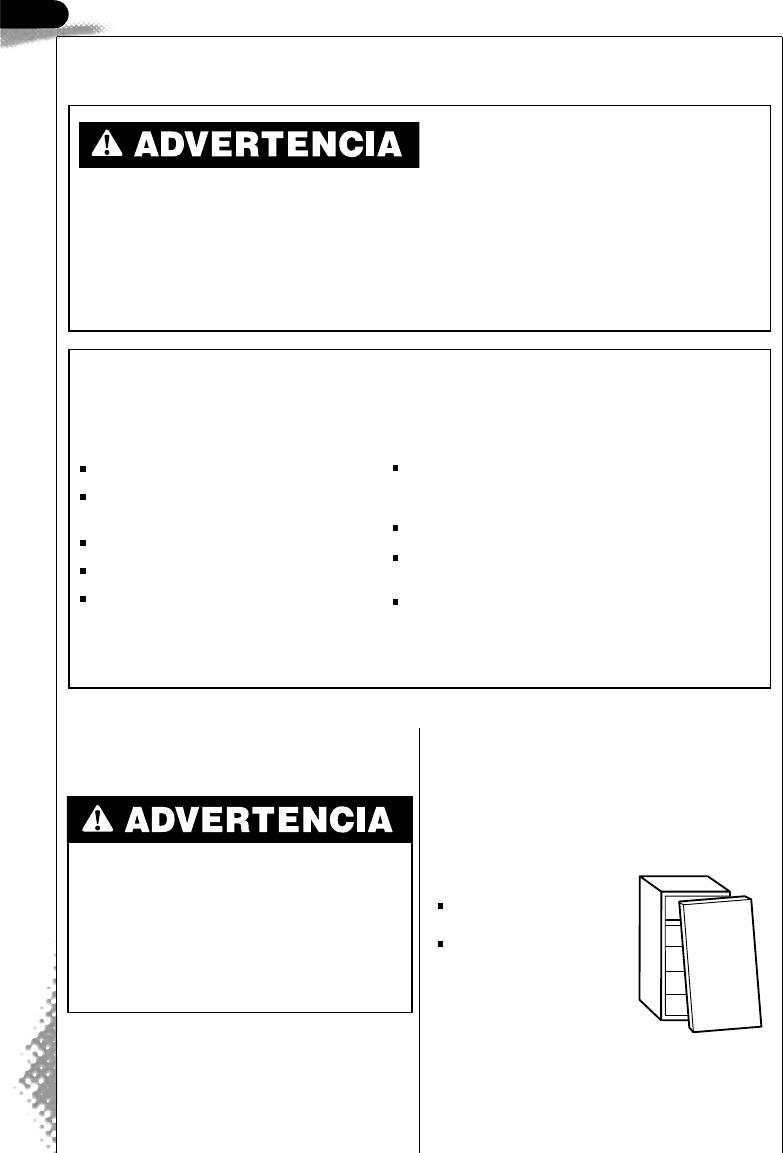
Este es el símbolo de alerta de seguridad.
Este símbolo le alerta de los riesgos potenciales que pueden resultar en
muerte o lastimarlo en el caso de que no siga las instrucciones de seguridad.
Todos los mensajes de seguridad mencionan cuál es el riesgo en potencial, cómo
reducir la probabilidad de lastimarse y lo que puede suceder si las instrucciones
no son seguidas.
SEGURIDAD DEL FREEZER
INSTRUCCIONES IMPORTANTES DE SEGURIDAD
ADVERTENCIA: Para reducir el riesgo de incendio, conmoción eléctrica o lesiones
cuando use su freezer, siga estas precauciones básicas:
No remueva el cable tierra.
Conecte el cable tierra a un tierra
efectivo.
No use adaptadores.
No use cordones de extensión.
Desenchufe el producto antes de
limpiarlo o repararlo.
TENGA ESTAS INSTRUCCIONES EN MENTE
Después de la limpieza o reparación,
reponga todos los componentes antes de
conectar el producto.
Use productos de limpieza no inflamables.
Mantenga productos inflamables, tales
como gasolina, lejos de su freezer.
Use dos o más personas para mover e
instalar el freezer.
Eliminación Apropiada de
su Freezer Antiguo
Riesgo de Sofocación
Remueva las puertas de su
freezer antiguo.
El incumplimiento de esta
instrucción puede resultar en
muerte o lesiones graves.
Freezers viejos o abandonados todavía
son peligrosos especialmente para los
niños pues ellos pueden atrancarse
dentro del producto, corriendo el riesgo
de sofocación.
Antes de deshacerse de su freezer
antiguo:
Retire las puertas.
Deje los estantes en
su lugar apropiado
para que los niños no
puedan entrar.
1Avisos de Seguridad
12
ESPAÑOL
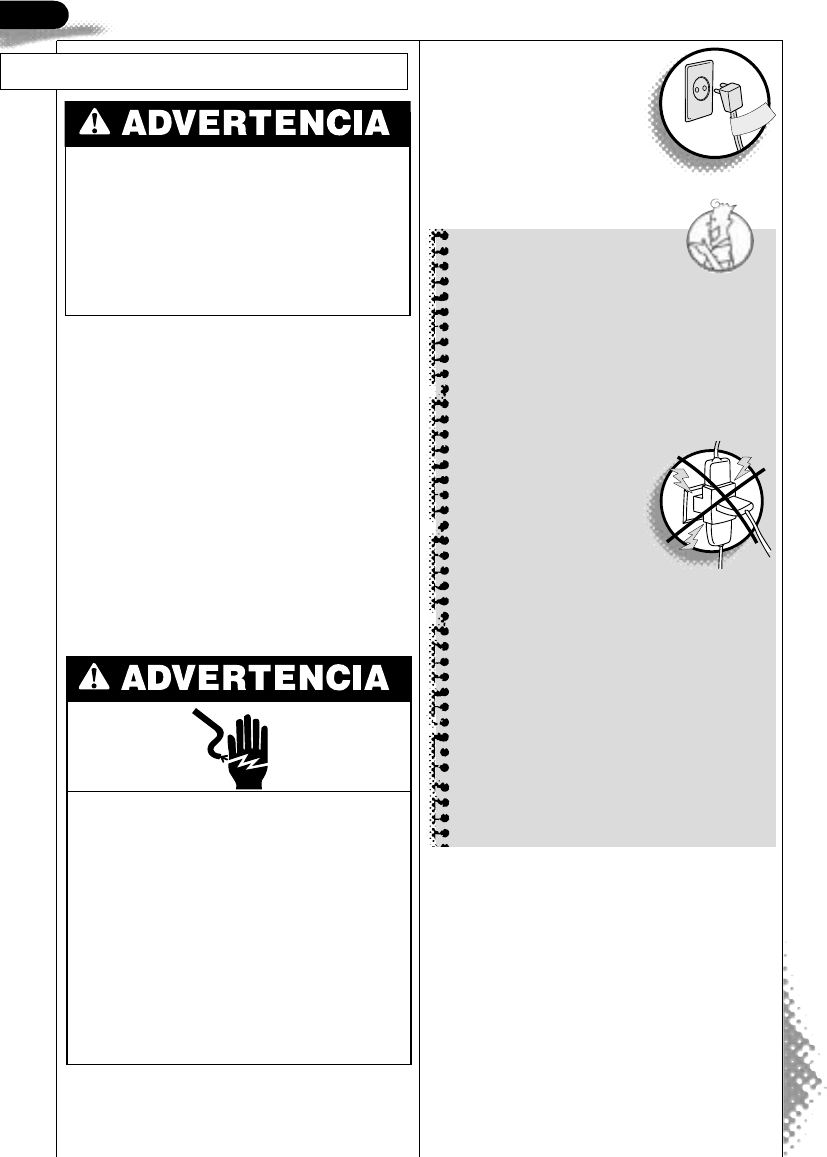
la misma de la
indicada en la
etiqueta fijada
próxima al enchufe.
El freezer debe ser
conectado a un
tomacorriente en
buen estado.
2
13
ESPAÑOL
Por Dónde Empiezo?
Antes de conectar:
✔ Retire la base del embalaje. Retire
cuñas y cintas de los componentes
internos.
✔Limpie el interior de su freezer con
un paño o esponja suave, agua tibia
y jabón suave.
✔No utilice objetos puntiagudos,
alcohol, productos inflamables o
productos de limpieza abrasivos.
Ellos pueden dañar la pintura de su
freezer y/o circuito refrigerante.
✔No colocar ni utilizar aparatos
eléctricos dentro del producto.
Importante:
✔Nunca conecte su freezer a
cordones de extensión dobles o
triples junto con otro
electrodoméstico en el mismo
tomacorriente. No use un cordón
de extensión. Esto puede
sobrecargar el suministro de
energía eléctrica, perjudicando el
funcionamiento de su
freezer, y resultando
en accidentes con
fuego.
Use solamente un
tomacorriente
exclusivo.
✔En el caso de oscilación en la
tensión de la red eléctrica, instale
un estabilizador automático de
tensión con potencia mínima de
1000W entre el freezer y el
tomacorriente.
✔Si el cable de alimentación
estuviera dañado, el mismo debe
ser reemplazado por un cable de
alimentación o un conjunto
especial provisto por el fabricante
o su servicio técnico autorizado.
INSTALANDO
Riesgo de Peso Excesivo
Use dos o más personas para
mover e instalar el freezer.
El incumplimiento de esta
instrucción puede resultar en
lesiones en la espalda u otras.
Riesgo de Conmoción Eléctrica
Conecte el cable tierra a un
tierra efectivo.
No remueva el cable tierra.
No use un adaptador.
No use un cordón de extensión.
El incumplimiento de estas
instrucciones puede resultar en
muerte, incendio o conmoción
eléctrica.
✔Chequee si la tensión de la red
eléctrica del lugar de instalación es
V
O
L
T
A
J
E
Suministro de energía eléctrica de
su residencia:
Los cables de la red eléctrica de su
residencia deben ser de cobre y tener
secciones mínimas de 2,5 mm2.
Conexión a tierra:
Para su seguridad, conecte
apropiadamente el cable tierra de su
freezer (cable verde detrás del
producto). La conexión inadecuada
del cable tierra puede resultar en
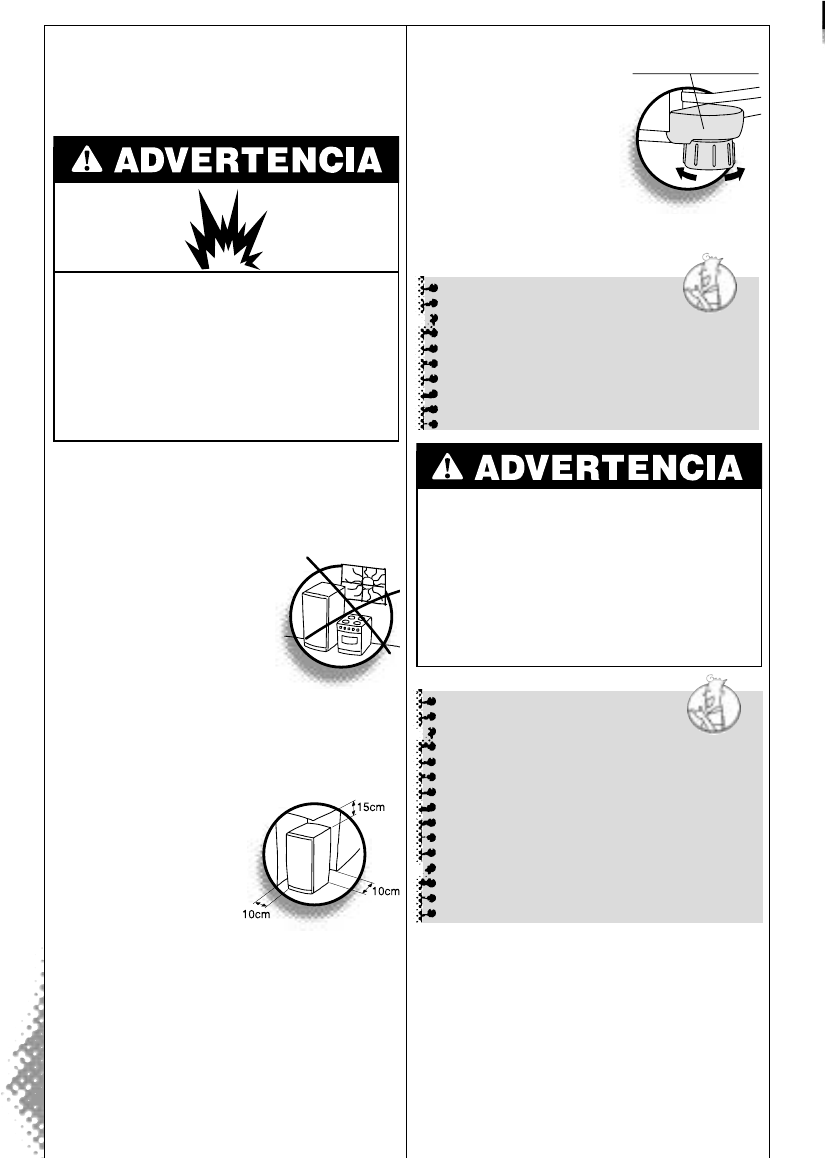
14
ESPAÑOL
Ubicación:
El freezer no debe ser instalado
próximo a fuentes de calor (cocina,
calentadores, etc.) ni en un lugar donde
esté expuesto en forma
directa a la luz del sol.
La instalación en un
lugar inadecuado
perjudica el
funcionamiento del
freezer y aumenta el
consumo de energía.
Cómo empotrar el freezer:
Considere las siguientes distancias
mínimas para
garantizar una
circulación de aire
adecuada:
✔10 cm en las
partes laterales.
✔10 cm en el
fondo.
✔15 cm en la parte superior.
De este modo, Ud. estará garantizando
el buen desempeño de su freezer e
impidiendo que sus componentes
toquen paredes, otros productos o
muebles, evitando ruídos
desagradables.
Riesgo de Explosión
Mantenga materiales inflamables,
tales como gasolina, lejos del
freezer.
El incumplimiento de estas
instrucciones puede resultar en
muerte, explosión o incendio.
Importante:
✔ Para facilitar el cierre de la
puerta, gire un poco más las
patas estabilizadoras,
inclinando levemente el
producto hacia atrás.
Reversión de la puerta:
Su freezer viene de fábrica con las
puertas instaladas de modo que abran
hacia la izquierda. Si Ud. desea que
ellas abran hacia la derecha, llame al
servicio técnico autorizado o a su
revendedor para evitar el riesgo de
accidentes. Este servicio no lo cubre la
garantía, servicio con cargo.
Riesgo de Incendio
Nunca coloque velas encendidas
o productos similares (velón)
sobre el freezer.
El incumplimiento de esta
instrucción puede resultar en
riesgo de vida o incendio.
Nivelación:
Coloque el freezer en
el lugar elegido.
Gire las patas
estabilizadoras,
ubicadas en la parte
delantera del
producto, hasta que
toquen el suelo, estabilizando el
producto.
Calentamiento en los
laterales:
✔ El calentamiento de algunas
regiones externas del freezer es
normal. Esto ocurre para evitar
condensaciones. Sin embargo, en
situaciones críticas de temperatura
y humedad ambiente, puede
ocurrir condensación. Séquelo
con un paño suave.
conmoción eléctrica u otras lesiones.
Si el lugar de instalación no posee un
tierra, consulte a un electricista
confiable para que le proporcione uno.
Protección patas
estabilizadoras
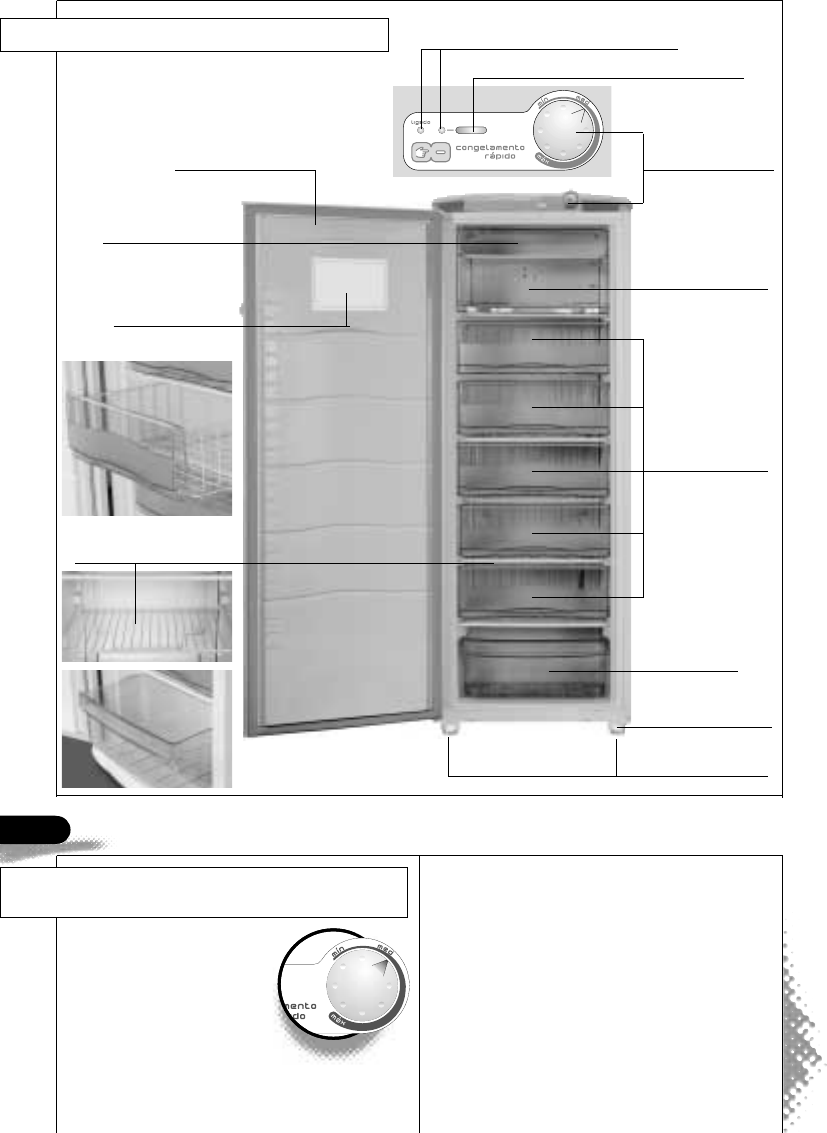
15
ESPAÑOL
CARACTERÍSTICAS GENERALES
Etiqueta con
Informaciones
de Uso
Patas
Estabilizadoras
Control de
Congelamiento.
Compartimiento
Congelamiento
Rápido
Compartimiento
Superior
Cajón
Inferior
(removible)
Protección Patas
Estabilizadoras
Cestos
Removibles
(para modelo
260 - 4 cestos)
Puerta Reversible
Reja Removible
(para modelo 260)
Indicadores Luminosos
(energía y congelamiento rápido)
Pulsador de Congelamiento Rápido
3Usando El Freezer
La temperatura interna
de su freezer puede ser
regulada para mejor
atender las
condiciones de
conservación de los
alimentos, conforme la
temperatura ambiente de su residencia.
COMO OPERAR EL CONTROL DE
CONGELAMIENTO
El control de congelamiento de su
freezer ya viene regulado de fábrica
en la posición Mediana.
Su alteración solamente debe ser
hecha de acuerdo con la tabla abajo.
La temperatura interna es ajustada
girando el botón de control de
congelamiento hasta la posición
deseada.
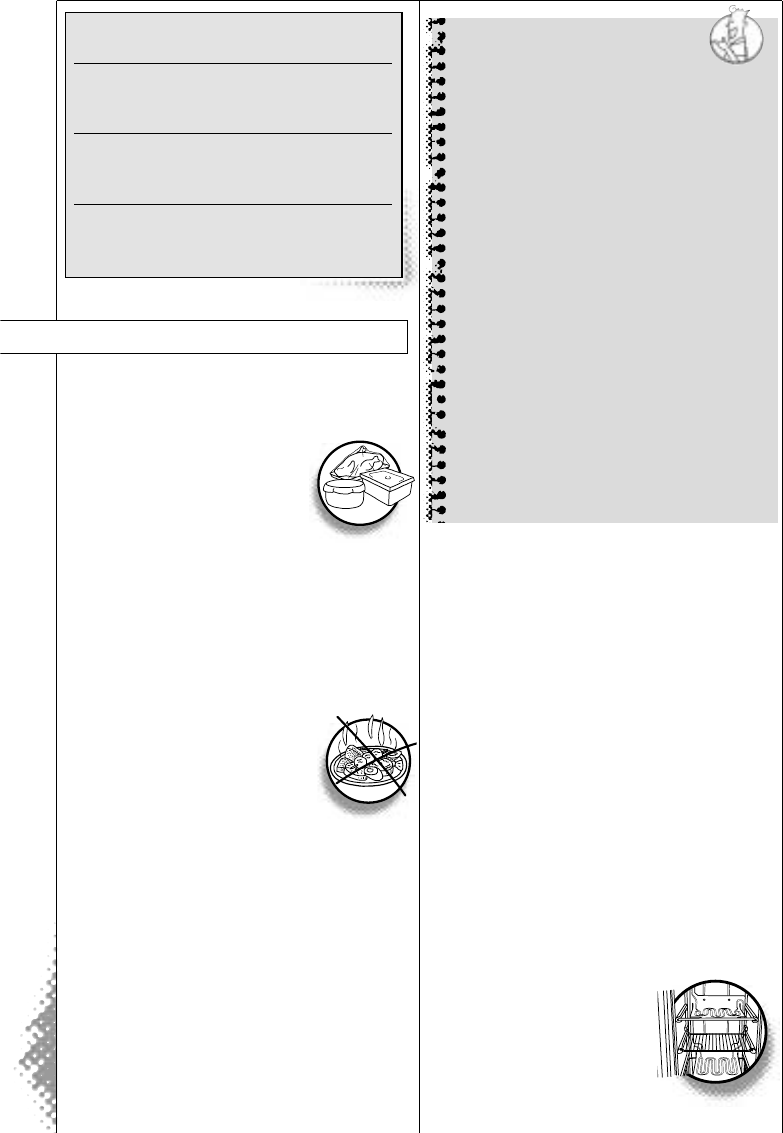
16
ESPAÑOL
✔ Los alimentos deben ser
almacenados en embalajes
apropiados, tales como sacos
plásticos o recipientes
con tapas. Eso evita la
remoción de la humedad
natural de los alimentos,
manteniendo su calidad.
✔Al almacenar alimentos en el freezer,
prepare pequeñas porciones. Eso
posibilitará un congelamiento más
rápido y la utilización integral de
cada porción.
✔ No coloque alimentos calientes en el
freezer. Aguarde que estén a la
temperatura ambiente.
Eso contribuye para que
no aumente el consumo
de energía, garantizando
el buen funcionamiento
del producto.
✔ Busque abrir la puerta solamente el
tiempo necesario para colocar o
retirar alimentos. De este modo,
usted estará reduciendo el consumo
de energía y mejorando el
desempeño de su freezer.
✔ Aguarde 1 minuto como mínimo
antes de abrir la puerta del freezer.
El vacío interno dificulta la apertura
inmediata de la puerta después del
cierre.
Posición - nivel
de congelamiento
Mínimo
Mediano
Máximo
Temperatura
ambiente
Días fríos con
temperatura abajo
de 20°C
Días con
temperatura entre
20°C y 35°C
Días calientes con
temperatura
arriba de 35°C
ALMACENANDO ALIMENTOS
Importante:
✔Se recomienda mantener el
freezer operando por 2 horas
como mínimo antes de proveerlo
con alimentos, tiempo necesario
para la estabilización de la
temperatura en el interior del
producto.
✔Si se descongela el alimento, no
se debe congelar nuevamente
porque éste puede perder sus
características naturales.
✔Los líquidos aumentan de
volumen cuando son congelados.
Por eso, tenga cuidado al
almacenar botellas u otros
recipientes cerrados por un
período prolongado en el freezer.
Estos recipientes pueden romperse.
✔No almacene productos tóxicos
en su freezer pues ellos pueden
contaminar los alimentos.
✔ Todo freezer posee capacidad
de congelar una cantidad máxima de
alimentos cada 24 horas.
Evite exceder la capacidad de
congelamiento de su producto, que
usted puede conferir en las
“Características Técnicas” (pg. 20).
✔ Observe siempre la fecha de
vencimiento de los productos
congelados, indicada por el
fabricante.
✔ Al abrir la puerta, es normal ocurrir
empañado en el cajón inferior, partes
delanteras de los cestos y en la puerta
del compartimiento de congelamiento
rápido de su freezer, debido a la
entrada de aire caliente.
Utilizando la reja (removible):
Para almacenar mayor
cantidad de alimentos o
alimentos grandes, retire
los cestos y apoye los
alimentos sobre la reja y
los estantes.
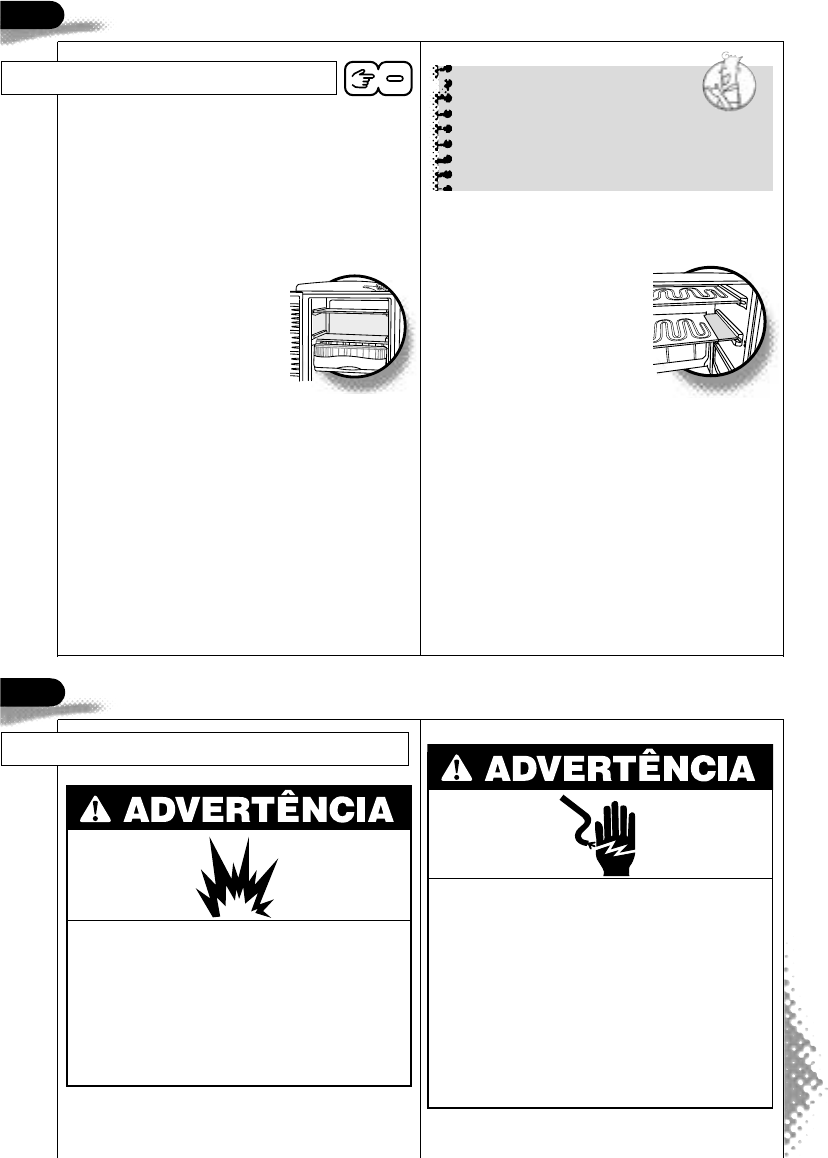
17
ESPAÑOL
Componentes del Freezer
4
El congelamiento rápido es una manera
eficaz de mantener las características
naturales de los alimentos. Por medio
del congelamiento rápido, la fase de
cristalización del hielo, que ocurre entre
las temperaturas de 0°C a -5°C, es
ultrapasada más rápidamente,
minimizando la pérdida de agua de los
alimentos y por lo tanto,
manteniendo su
constitución natural.
El congelamiento de los
alimentos ocurre
gradualmente.
✔ Su freezer posee un compartimiento
ideal para acelerar el congelamiento
de los alimentos.
✔ Para un congelamiento rápido,
coloque los alimentos en este
compartimiento y accione el pulsador
de “Congelamiento Rápido” en el
panel de control. La luz amarilla del
panel se encenderá indicando que la
función congelamiento rápido está
accionada. Esta función no se
desconecta automáticamente.
CONGELAMIENTO RÁPIDO
Importante:
✔Se recomienda desconectar la
función congelamiento rápido
después de 26 horas.
M
Í
N
I
M
A
M
✔ Estos modelos de freezers poseen
un complemento plástico en la
derecha del segundo
estante.
En las condiciones
normales de uso, no
habrá formación de
hielo en esta región.
✔En el caso de que quiera
interrumpir la función
congelamiento rápido, apriete
nuevamente a cualquier momento
el pulsador que acciona esta
función.
✔Ver capacidad de congelamiento
en las “Características Técnicas”
(pg. 20).
Mantenimiento y Cuidados
5
DESCONGELAMIENTO Y LIMPIEZA
Riesgo de Explosión
Use productos de limpieza no
inflamables.
El incumplimiento de esta
instrucción puede resultar en
muerte, explosión o incendio.
Riesgo de Conmoción Eléctrica
Desconecte el enchufe del
tomacorriente antes del
mantenimiento.
Sustituya todos los componentes
antes de conectar el producto.
El incumplimiento de estas
instrucciones puede resultar en
muerte o conmoción eléctrica.
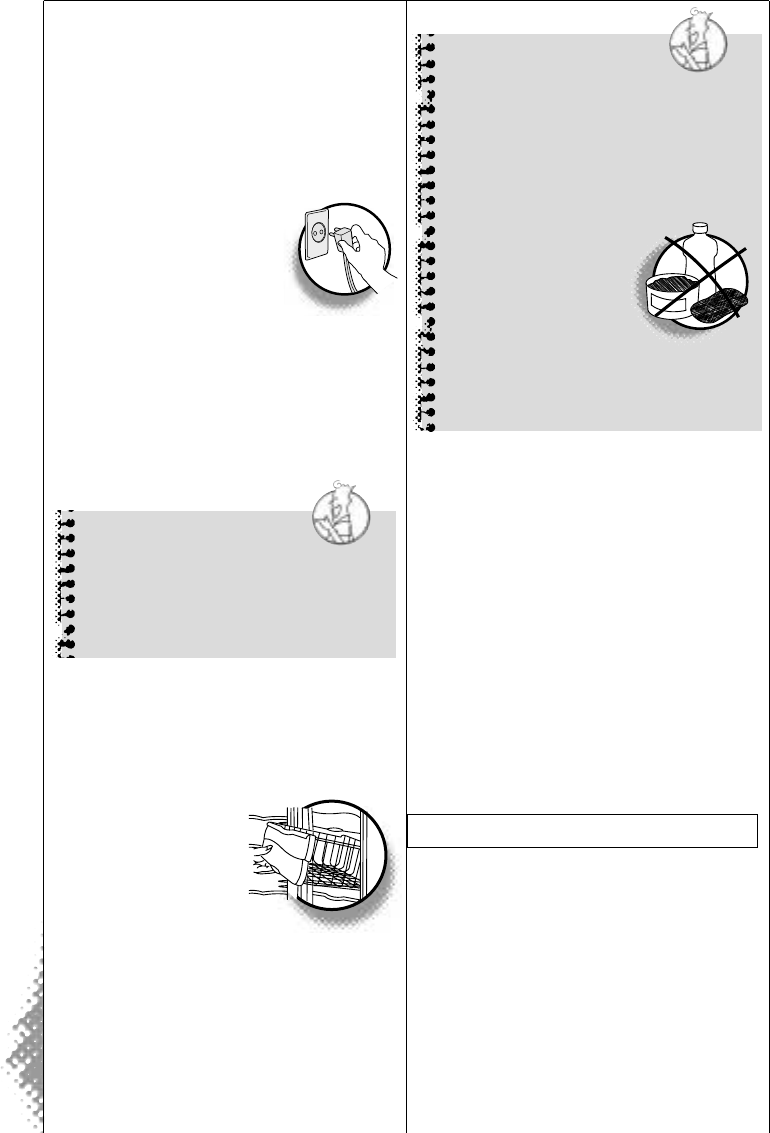
18
ESPAÑOL
Se recomienda efectuar el
descongelamiento por lo menos cada 6
meses, o cuando la capa de hielo
alcance 1 cm de espesura.
Preferentemente, el descongelamiento
debe ser hecho cuando haya pocos
alimentos en el freezer, siguiendo los
pasos a continuación:
✔ Antes de hacer el
descongelamiento y/o
una limpieza general,
desconecte el enchufe
del tomacorriente.
✔ Embale los alimentos y coloque uno
junto al otro en el local más frío de
su refrigerador o en algún recipiente
térmico.
✔ Deje la puerta abierta para acelerar
el descongelamiento.
Importante:
✔ Nunca utilice objetos cortantes
o puntiagudos para remover el
hielo, pues usted puede dañar
el producto.
✔ Coloque correctamente el cajón
inferior. Es en este cajón que escurre
la mayor parte del agua resultante
del descongelamiento.
✔ Para remover los
cestos, basta con
tirarlos e
inclinarlos hacia
arriba.
✔ Terminado el descongelamiento,
retire el cajón y tire el agua.
✔ Limpie el interior de su freezer.
Importante:
✔ Nunca utilice productos tóxicos
(amoníaco, alcohol,
removedores, etc.) o abrasivos
(jabón de pulir, pastas, etc.) ni
limpiador de acero o cepillos en
la limpieza de su freezer.
Estos productos pueden
dañar su freezer
y dejar olores
desagradables
en el interior
del mismo.
✔Evite también el contacto de
estos productos con su freezer,
pues podrán dañarlo.
✔Use una esponja o paño suave
humedecido en agua con
detergente o jabón neutros.
Enjuague bien y seque con paño
limpio y seco.
✔Para limpiar la parte externa
trasera, use solamente un aspirador
de polvos o un plumero.
✔ Después de la limpieza, conecte el
enchufe en el tomacorriente.
Si es necesario ajuste el control de
congelamiento en la posición
deseada.
VIAJES Y AUSENCIAS
✔ Acuérdese de que puede haber falla
de energía eléctrica por un largo
período de tiempo mientras usted
esté fuera y, en este caso, el
descongelamiento de los alimentos
causará la degradación de los
mismos.
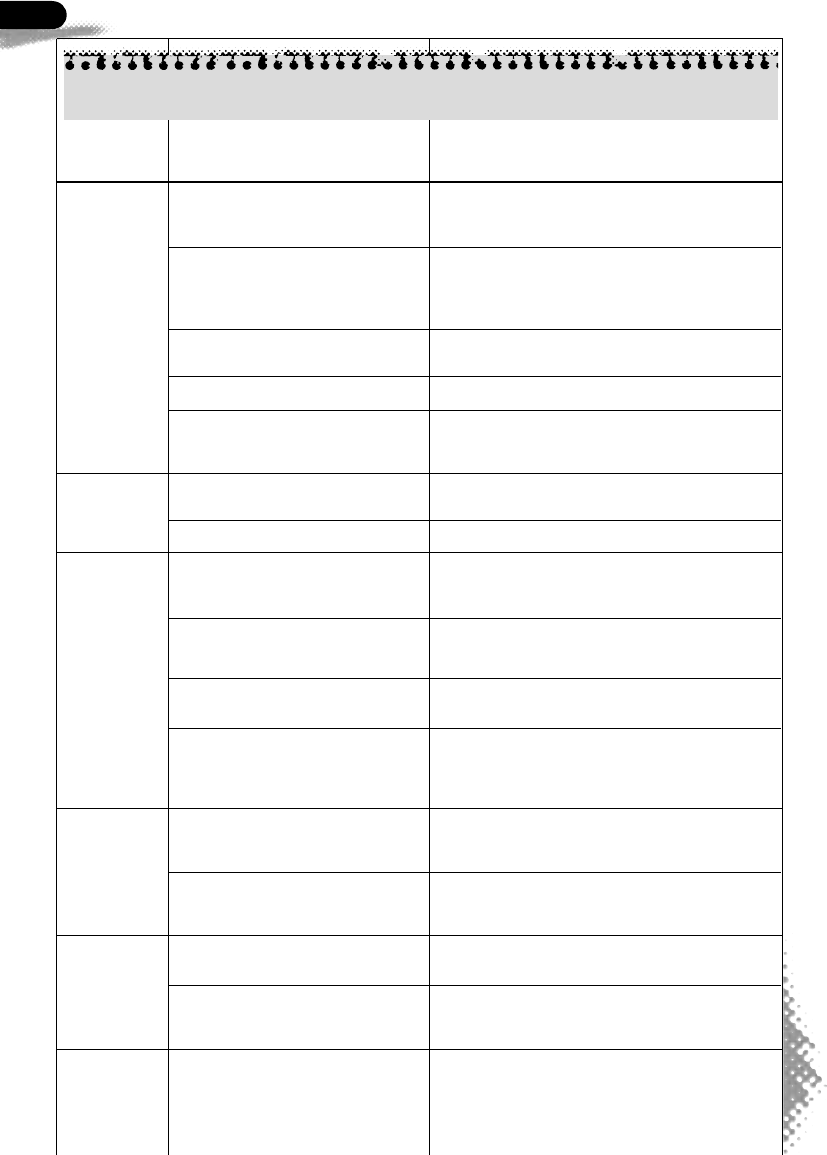
19
ESPAÑOL
Verifique el fusible o el disyuntor de la
residencia. Vea también si el enchufe está
conectado en el tomacorriente.
Instale un estabilizador automático de
voltaje con potencia mínima de
1000 Watts. 13
Conecte otro aparato al tomacorriente
para verificar y cámbielo si es necesario.
Conéctelo.
Llame al servicio técnico autorizado o
consulte a su revendedor, para evitar riesgos
de accidentes. 13
Vea el punto “Por Dónde Empiezo”
(Instalación). 14
Regule las patas estabilizadoras. 14
Ajústelo, conforme el punto “Usando el
Freezer” (Como Operar el Control de
Congelamiento). 15
Verifique si algún objeto está impidiendo
el cierre completo de la puerta.
Si es necesario, reorganice los alimentos.
Dígale a las personas que abran las puertas
solamente cuando sea necesario. 16
Observe la capacidad máxima de
congelamiento, haciendo uso del
compartimiento de congelamiento rápido.
Accione el pulsador de congelamiento rápido.17
Instale su freezer en lugar ventilado. 14
Séquelo con paño suave.
Regule las patas estabilizadoras de modo
que mantengan el freezer levemente inclinado
hacia atrás. 14
Dígale a las personas que abran las puertas
solamente cuando sea necesario. 16
Embale alimentos y/o tape recipientes
con líquidos. 16
Verifique si algún objeto está impidiendo el
cierre completo de la puerta. Si necesario,
reorganice los alimentos en su freezer.
Si la formación de hielo sigue, llame al servicio
técnico autorizado o consulte a su revendedor.
PROBLEMA CAUSA PROBABLE SOLUCIÓN
El freezer no
funciona.
Ruidos
anormales
Refrigeración
insuficiente
Condensación
externa
Condensación
interna
Formación de
hielo
Falla de energía.
Tensión muy bajo/alto (esto puede
ser observado por las oscilaciones
de luminosidad de las lámparas de
la casa).
Tomacorriente descompuesto.
Enchufe desconectado.
Cable de alimentación
dañado.
Instalación en lugar no adecuado.
Nivelación inadecuada.
Control de congelamiento en la
posición incorrecta.
Puerta mal cerrada.
Puerta siendo abierta con mucha
frecuencia.
Exceso de carga a ser congelada.
Colocación de carga a ser
congelada fuera del compartimiento
de congelamiento rápido.
Elevada humedad del aire ambiente
(normal en ciertos climas y épocas
del año).
Mala vedación magnética de la
puerta.
Apertura de puerta muy frecuente.
Alimentos desembalados y/o
recipientes con líquidos destapados
(humedad excesiva).
Infiltración de humedad por la
puerta.
MAYORES
INFORMACIONES EN
LA PÁGINA
Antes de llamar al servicio técnico autorizado o a su revendedor, intente las
soluciones, consultando la tabla a continuación.
6Soluciones de Pequeños Problemas
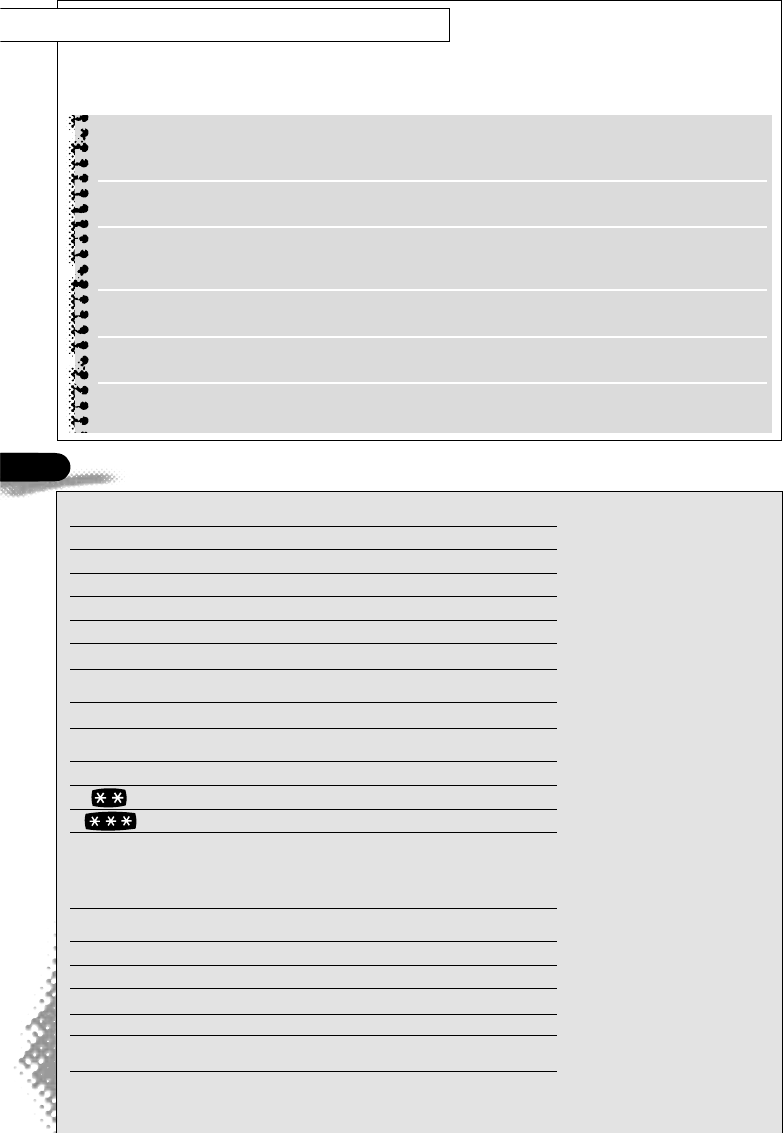
20
ESPAÑOL
Los estallos son debido al desplacamiento de hielo.
Es el mismo ruido que ocurre cuando cubetas de hielo son
retiradas del freezer y expuestas a la temperatura ambiente.
Ruido característico de motor. Significa que el compresor está
en funcionamiento.
Ruido característico de la expansión del gas en el sistema de
refrigeración. Es un ruido semejante al generado cuando se
llena un balón de gas.
Ruido característico de agua escurriendo.
Ocurre cuando el producto está haciendo el descongelamiento.
Ocurre al cerrar la puerta. Ruido semejante al generado
cuando se vacía un globo aerostático.
Ruido característico de piezas vibrando. Ocurre cuando los
cestos están vacíos.
Estallos
Ruidos del
Compresor
Ruido de expansión
de gas
Ruido de
descongelamiento
Ruido en la
vedación magnética
Ruido interno
RUIDOS CONSIDERADOS NORMALES
Algunos ruidos son considerados propios del funcionamiento del freezer.
A continuación, presentamos una tabla descriptiva de los ruidos característicos del
funcionamiento.
Modelo 300 260
Dimensiones sin embalaje (mm) (mm)
Alto 1700 1539
Ancho 616 616
Ancho con la puerta abierta a 130° 1139 1139
Profundidad 691 691
Profundidad con la puerta abierta a 90° 1206 1206
Capacidad bruta (litros) (litros)
Total 296 260
Capacidad de almacenaje(*) (litros) (litros)
Total 246 231
Compartimiento superior 20 20
Compartimiento freezer 226 211
Capacidad de congelamiento
(en hasta 24 horas con el pulsador de
congelamiento rápido accionado) 11,0 kg 10,0 kg
Peso máximo sobre componentes (kg) (kg)
Compartimiento congelamiento rápido 20,0 20,0
Cestos (cada) 20,0 20,0
Cajón inferior 20,0 20,0
Reja 20,0 20,0
Peso sin embalaje (kg) 63,0 56,0
7Características Técnicas
El fabricante se reserva el
derecho de modificar las
características generales,
técnicas y estéticas de sus
productos sin aviso previo.
*
Para obtenerse la
capacidad máxima de
almacenaje del
modelo 260, se debe
retirar todos los cestos
excepto el primer
cesto después del
compartimiento
congelamiento rápido.
Para el modelo 300,
se deben retirar el
segundo y el cuarto
cestos.

326042547
20/08/2004